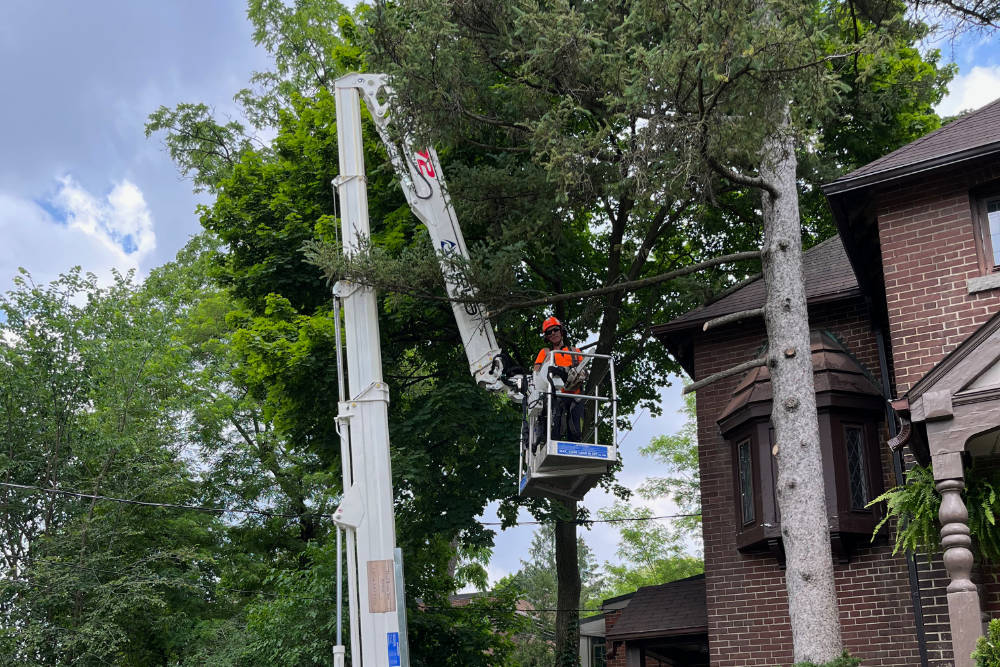Tree And Shrub Pruning Services We Offer

Lorem ipsum
Mature Tree Pruning
Mature tree pruning involves the removal of dead, diseased, and dying branches as well as branches with structural defects and pruning to ensure adequate clearance from adjacent infrastructure. Properly pruning mature trees can help protect your property and preserve and promote tree health and structure.

Lorem ipsum
Clearance Pruning
Clearance pruning involves removal of select branches to clear adjacent infrastructure including houses, driveways, playgrounds, other trees, power lines, signage etc…

Lorem ipsum
Crown Raising / Elevation
Crown raising involves the removal of lower limbs to provide overhead clearance for people, vehicles, signage, and more visibility to and from buildings, and/or more light to a specific area.

Lorem ipsum
Thinning (Reduce Crown Density)
Thinning is performed to increase air and light penetration into the inner canopy. This is sometimes done for aesthetic reasons, and/or to control for certain diseases. Trees that have been pruned for good structure often do not require thinning as structural pruning reduces crown density. Over thinning or lion-tialing trees is not an acceptable practice and can result in the decline of tree health as well as structural issues.

Lorem ipsum
Risk Mitigation Pruning
Risk mitigation pruning is one of the most common objectives when pruning trees in Toronto. Risk mitigation involves pruning to remove dead, diseased, dying and structurally flawed branches in order to reduce the likelihood of branch or whole tree failure. Risk mitigation is almost always a component of mature tree pruning.

Lorem ipsum
Crown Reduction And Retrenchment Pruning
Crown reduction is sometimes done for aesthetic reasons but is more often done as part of risk mitigation and maintenance pruning and involves shortening select branches to reduce weight and leverage, thereby reducing likelihood of branch failure. When conducting crown reduction, it is important to cut branches back to a suitably sized lateral branch and not make large cuts if possible.

Lorem ipsum
Crown Reduction And Retrenchment Pruning
Crown reduction is sometimes done for aesthetic reasons but is more often done as part of risk mitigation and maintenance pruning and involves shortening select branches to reduce weight and leverage, thereby reducing likelihood of branch failure. When conducting crown reduction, it is important to cut branches back to a suitably sized lateral branch and not make large cuts if possible.
Retrenchment pruning is a type of crown reduction done on certain species of mature trees that is intended to mimic the natural crown reduction process that occurs in nature. Retrenchment pruning is done to declining, mature trees by removing the outermost, overextended branches, decayed and/or structurally flawed branches and leaving intact the most vigorous lower and inner canopy growth. The tree’s resources are then directed to the remaining growth and a lower, smaller and more dense canopy is formed. This is a useful technique for preserving high value or veteran trees. It is also useful as a risk mitigation technique to rescue the likelihood of branch or whole tree failure.

Lorem ipsum
Crown Restoration
Crown Restoration (also called corrective pruning) is a method used to improve a tree’s structure or form after it has been damaged through incorrect pruning or branch failure. This usually takes several pruning cycles and is done in conjunction with risk mitigation pruning.

Lorem ipsum
Structural Pruning
Structural pruning involves pruning to establish and maintain good branch structure. This includes establishing a dominant central leader, subordinating and/or removing competing branches, and the removal of crossing and rubbing branches. Structural pruning is usually done on younger trees because they have greater stored energy reserves and can quickly close pruning wounds.

Lorem ipsum
Hedge Trimming
At Higher Place Tree Care, we are experts at trimming hedges of all sizes and species. In order to maintain their health and shape, hedges require regular pruning or trimming. Hedge trimming involves shearing the hedge to maintain its shape and to ensure it remains compatible with the landscape of the property. Depending on species, the frequency of pruning, timing of pruning and amount of live growth to be removed can vary. It is important to retain a qualified arborist to keep your hedge healthy and aesthetically pleasing.

Lorem ipsum
Aesthetic And Ornamental Pruning
Trees and shrubs that are part of a manicured landscape are often pruned for a particular aesthetic. This pruning involves shaping the crowns of ornamental trees and shrubs and removing dead, diseased and dying branches. At Higher Place tree Care we are experts in aesthetic pruning of ornamental trees and shrubs.

Lorem ipsum
Fruit Tree Pruning
Fruit trees are often pruned for a structure that promotes fruit growth, are able to withstand the weight of the fruit and allows for easier harvesting. Maintaining fruit trees for fruit growth requires more frequent pruning than typical landscape trees.